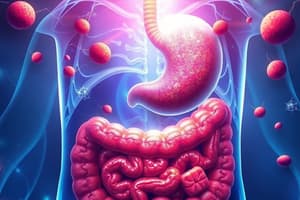Podcast
Questions and Answers
What is the main function of the digestive system?
What is the main function of the digestive system?
- Respiratory functions
- Storage abilities
- Excretory functions
- Digestion and absorption (correct)
Which of the following is NOT part of the digestive system?
Which of the following is NOT part of the digestive system?
- Pancreas
- Gallbladder
- Stomach
- Liver (correct)
What is the main role of the lymphatic system?
What is the main role of the lymphatic system?
- Storage abilities
- Part of the immune system (correct)
- Circulatory functions
- Excretory functions
Which layer of tissue lines the lumen of the GI tract and is responsible for absorption?
Which layer of tissue lines the lumen of the GI tract and is responsible for absorption?
What are the end products of digestion absorbed by?
What are the end products of digestion absorbed by?
What does the contraction of smooth muscles in the GI tract do?
What does the contraction of smooth muscles in the GI tract do?
What is responsible for protecting the GI tract?
What is responsible for protecting the GI tract?
Which organ is NOT a part of the gastrointestinal tract (GIT)?
Which organ is NOT a part of the gastrointestinal tract (GIT)?
What is not absorbed and passes through GIT & excreted in feces?
What is not absorbed and passes through GIT & excreted in feces?
Which organ systems contribute to circulatory functions in the body?
Which organ systems contribute to circulatory functions in the body?
What is the primary theme of human nutrition?
What is the primary theme of human nutrition?
Which type of tissue is responsible for connecting and supporting other tissues in the body?
Which type of tissue is responsible for connecting and supporting other tissues in the body?
What are the 4 primary types of tissue in the human body?
What are the 4 primary types of tissue in the human body?
What do all cells need to function properly?
What do all cells need to function properly?
What is the smallest functional unit of the human body?
What is the smallest functional unit of the human body?
What is the continuous supply of energy required by cellular processes and chemical reactions in the form of?
What is the continuous supply of energy required by cellular processes and chemical reactions in the form of?
Which type of diseases are characterized by a slow onset and long duration?
Which type of diseases are characterized by a slow onset and long duration?
What is the main source of acute diseases according to the text?
What is the main source of acute diseases according to the text?
According to the World Health Organization, what do people's health, growth, and development largely depend on?
According to the World Health Organization, what do people's health, growth, and development largely depend on?
What is the definition of chronic diseases according to the text?
What is the definition of chronic diseases according to the text?
In terms of nutrition, what is more likely to affect the risk for developing chronic diseases?
In terms of nutrition, what is more likely to affect the risk for developing chronic diseases?
What are NCDs as defined in the lecture outline?
What are NCDs as defined in the lecture outline?
What is the main characteristic of non-communicable diseases (NCDs) according to the text?
What is the main characteristic of non-communicable diseases (NCDs) according to the text?
Which factor refers to the biochemical processes involved in the body's normal functioning?
Which factor refers to the biochemical processes involved in the body's normal functioning?
What risk factor can be estimated by measuring waist circumference?
What risk factor can be estimated by measuring waist circumference?
Which condition occurs more frequently in obese individuals?
Which condition occurs more frequently in obese individuals?
What is the estimated sodium intake equivalent to 6-gram sodium chloride (1 teaspoon salt)?
What is the estimated sodium intake equivalent to 6-gram sodium chloride (1 teaspoon salt)?
What is defined as having blood lipid levels that are too high?
What is defined as having blood lipid levels that are too high?
Which risk factor is a behavioral risk factor that can be reduced or controlled by intervention?
Which risk factor is a behavioral risk factor that can be reduced or controlled by intervention?
What is the classification for BMI (Body Mass Index) indicating overweight and obesity?
What is the classification for BMI (Body Mass Index) indicating overweight and obesity?
"An aspect of personal behavior or lifestyle, an environmental exposure, or a hereditary characteristic that is associated with an increase in the occurrence of a particular disease, injury, or other health condition." This definition refers to:
"An aspect of personal behavior or lifestyle, an environmental exposure, or a hereditary characteristic that is associated with an increase in the occurrence of a particular disease, injury, or other health condition." This definition refers to:
"Complex etiology (causes), multiple risk factors, and long latency period" are characteristics of:
"Complex etiology (causes), multiple risk factors, and long latency period" are characteristics of:
Flashcards are hidden until you start studying



